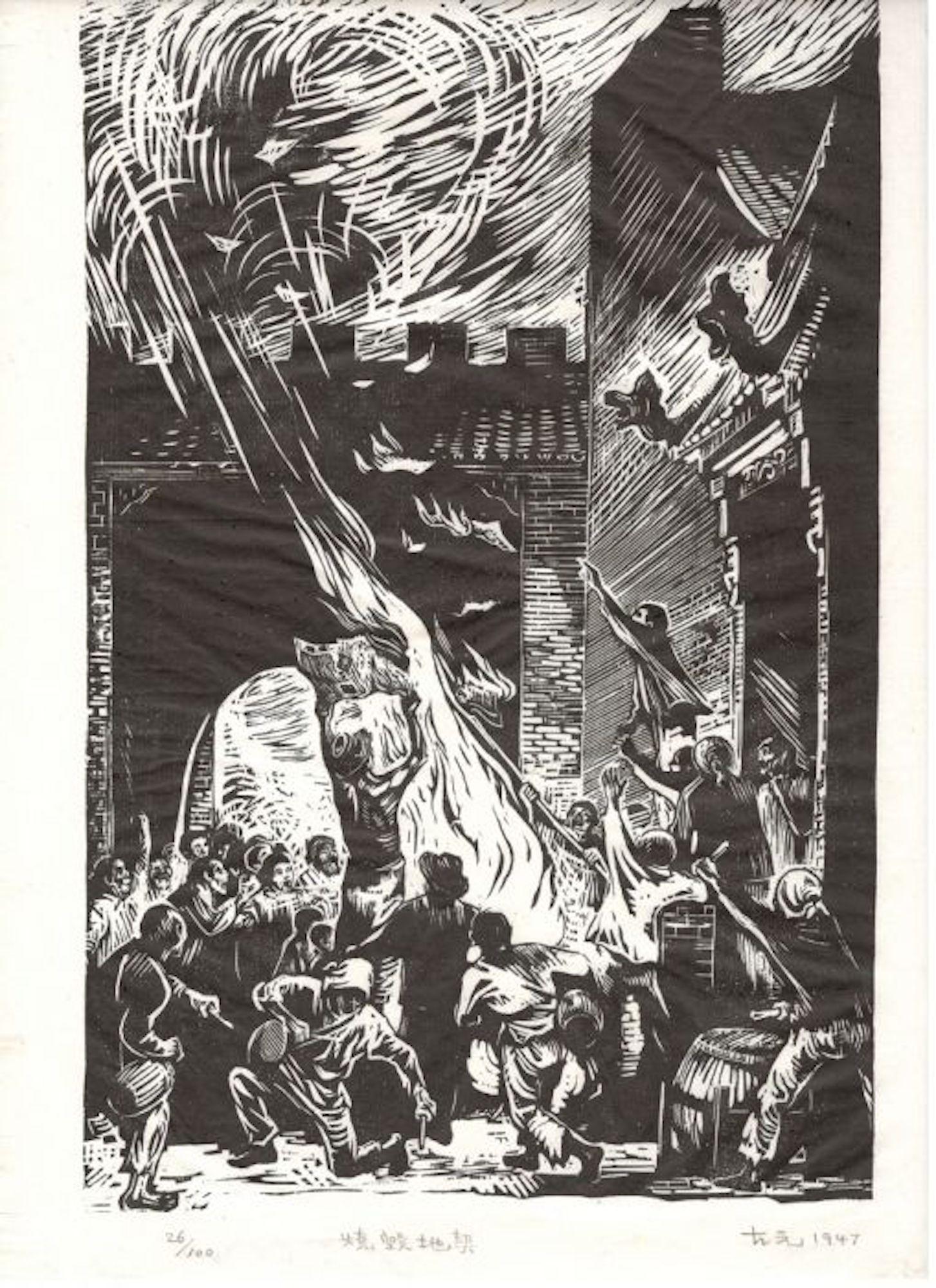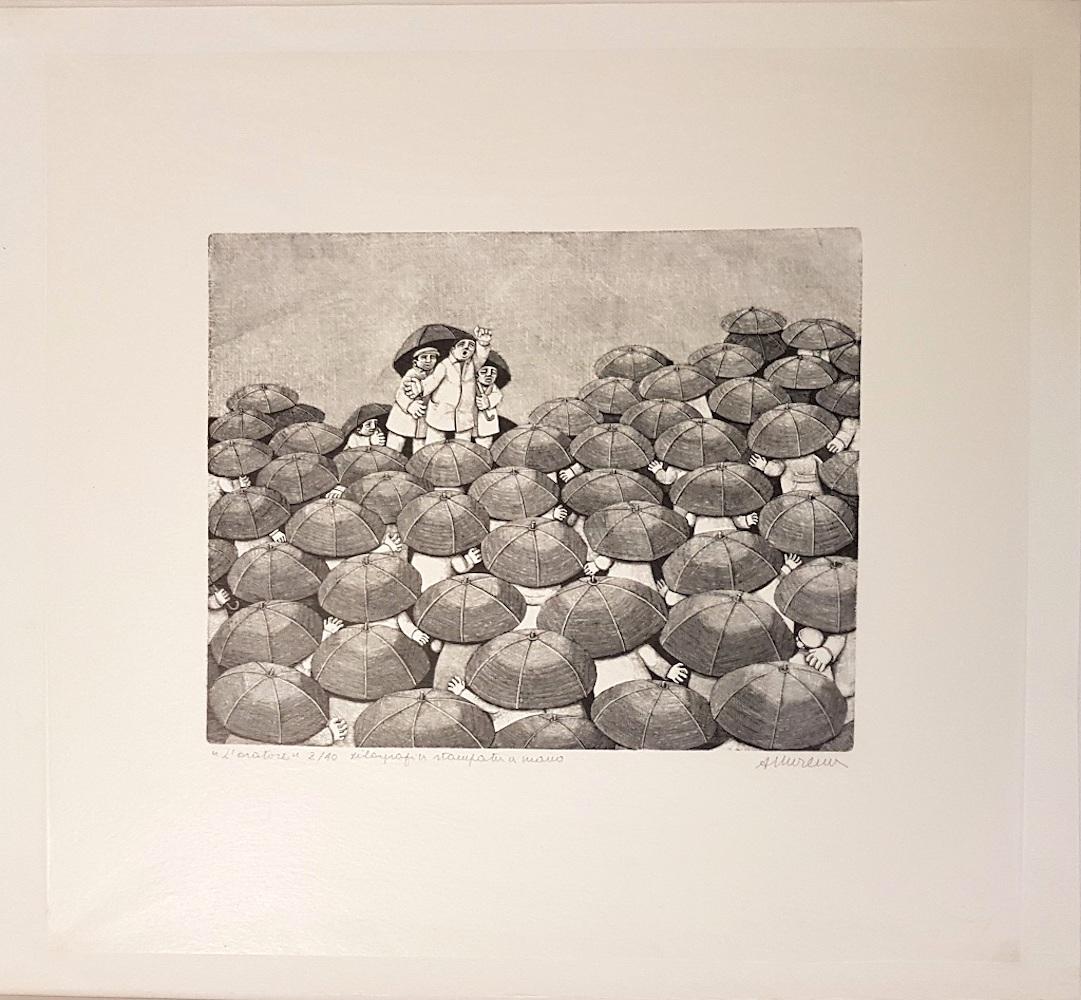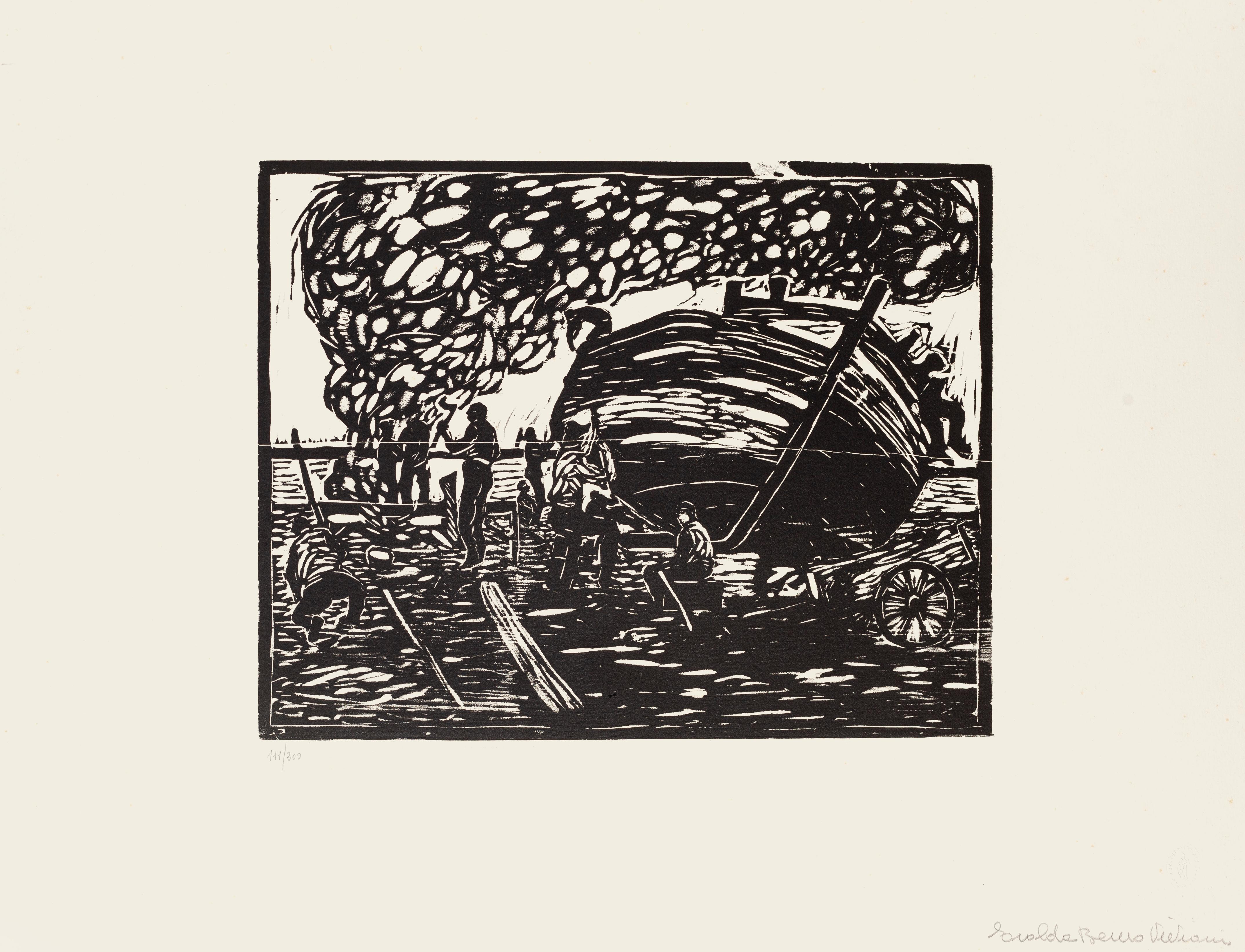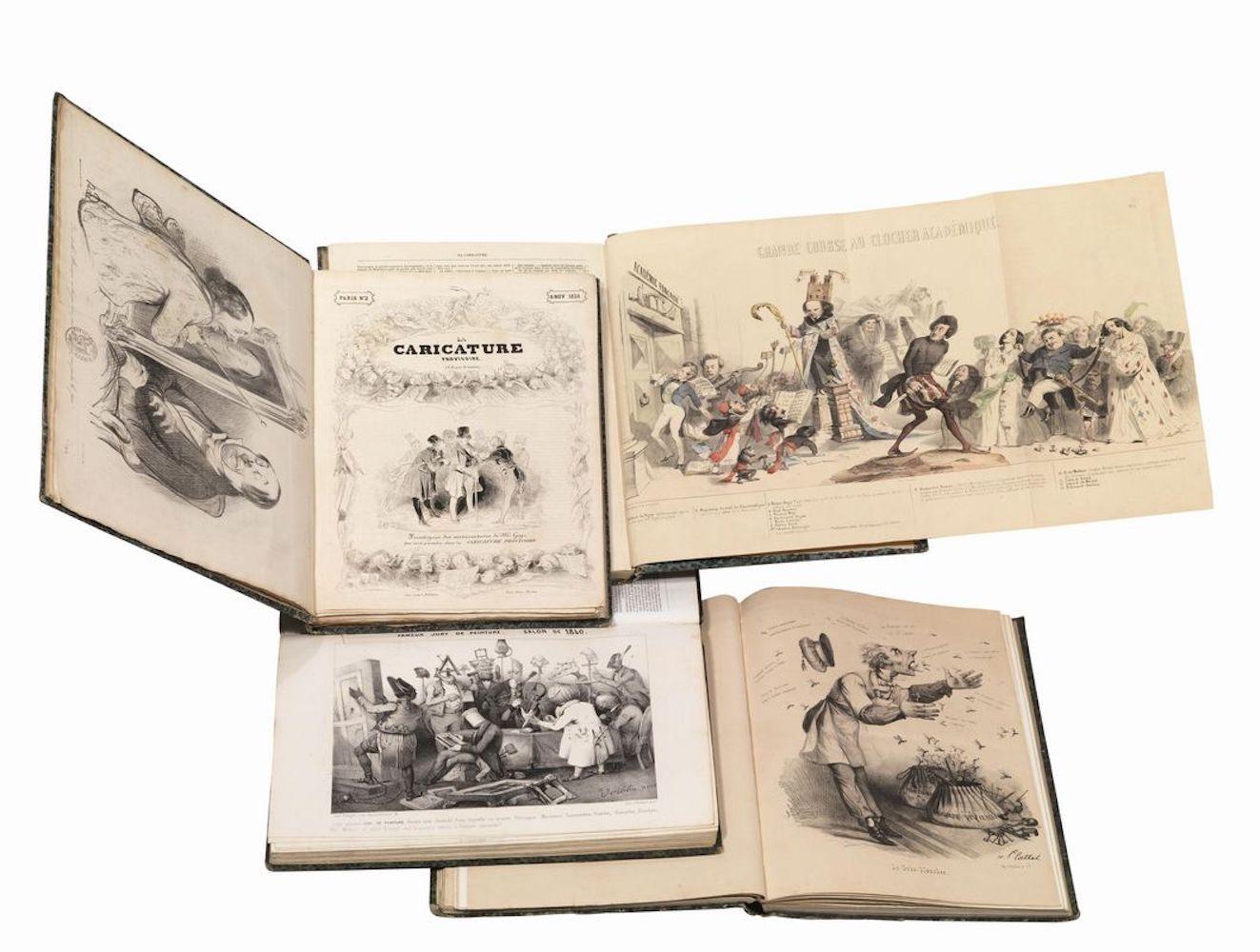Mino MaccariWomen - Woodcut by Mino Maccari - 1960s1960
1960
About the Item
- Creator:Mino Maccari (1898 - 1989, Italian)
- Creation Year:1960
- Dimensions:Height: 19.49 in (49.5 cm)Width: 27.76 in (70.5 cm)Depth: 0.04 in (1 mm)
- Medium:
- Period:
- Framing:Framing Options Available
- Condition:Insurance may be requested by customers as additional service, contact us for more information.
- Gallery Location:Roma, IT
- Reference Number:
Mino Maccari
Popular painter, engraver and journalist Mino Maccari is known for his often controversial and explosive prints, drawings and paintings, and is considered to be one of the most important Italian satirical artists of the 20th century.
Born in 1898 in Siena, Maccari joined the Italian Army at age 19 to serve in World War I as an artillery officer. Afterward, he attended law school, graduating in 1920 and working as a lawyer until 1926.
While working as a lawyer, Maccari developed an interest in painting and engraving, moonlighting as an artist. Despite his lack of formal training, his works captured the attention of local critics, and he debuted with the Group Labronico, an organization of like-minded Italian artists that included painter Beppe Guzzi.
In 1924, publisher Angiolo Bencini contacted Maccari to oversee the printing operations of Il Selvaggio, a fascist magazine in which Maccari’s first satirical illustrations and engravings appeared. Until 1942, Maccari was editor-in-chief of the controversial magazine, which featured contributions from Futurist artists such as Ardengo Soffici, Carlo Carrà and others.
Throughout his career, Maccari participated in numerous notable exhibitions and shows throughout Italy and Europe. His figurative drawings and paintings, portraits and exotic nude works gained considerable acclaim from critics and collaborative artists.
In 1927, he participated in the "Second International Exhibition of Modern Engraving" and the "Third Exhibition of the Tuscan Union of Arts." The following year, Maccari exhibited at the Venice Biennale, where he would win the International Prize for engraving in 1948.
From the late 1940s to 1963, Maccari collaborated with the liberal magazine Il Mondo, contributing several satirical illustrations and engravings. By this time, he had become a well-established and respected artist in Italy and, in 1959, was named director of the Academy of Fine Arts in Rome.
In 1963, Maccari was recognized again for his works, winning the Antonio Feltrinelli Prize for painting. That same year, he became president of the San Luca Academy.
Throughout the 1970s, Maccari continued painting and drawing, creating provocative works such as Dominatrix Woman, a bold work in watercolor and pastel, the diminutive pen drawing Trampled and his erotic charcoal and watercolor drawing Mata Hari.
Even after Maccari’s death in 1989, his works continue to be a talking point among avid modern art collectors.
Find original Mino Maccari drawings and watercolor paintings, prints and other art on 1stDibs.
- ShippingRetrieving quote...Ships From: Rome, Italy
- Return PolicyA return for this item may be initiated within 14 days of delivery.
- The Fire - Woodcut on Paper by Gu Yuan - 1947By Gu YuanLocated in Roma, ITImage dimensions: 28 x 18 cm. The Fire is an original artwork realized by Gu Yuan in 1947. Original xylograph on watermarked paper. Signed and dated in pencil on the lower right. ...Category
1940s Contemporary Figurative Prints
MaterialsWoodcut
- Les Martyrs Chrétiens - Original Woodcut by J. Nepomuk GeierLocated in Roma, ITLes Martyrs Chrétiens is an original artwork realized by Johann Nepomuk Geiger in the beginning of the XIX century. Original xilograph on paper. The sheet i...Category
19th Century Figurative Prints
MaterialsWoodcut
- The Orator - Original Woodcut by Alberico Morena - 1971By Alberico MorenaLocated in Roma, ITImage dimensions: 24 x 29.5 cm. Beautiful xilograph hand-printed on tissue-paper, 1971. Print representing a political public speech. Hand-signed with pencil on lower-right margin. ...Category
1970s Figurative Prints
MaterialsWoodcut
- Workers on the Seaside - Woodcut by Giuseppe Viviani - 1926By Giuseppe VivianiLocated in Roma, ITImage dimensions: 30 x 38 cm. "Workers" is an original xilography realized by Giuseppe Viviani in 1926; Hand-signed in pencil on the lower right, and numbered, edition of 111/200 p...Category
1920s Modern Figurative Prints
MaterialsWoodcut
- Self Portrait - Woodcut by Giuseppe Viviani - 1925By Giuseppe VivianiLocated in Roma, ITImage dimensions: 25.5 x 27 cm. "Self-Portrait" is an original xilography realized by Giuseppe Viviani in 1925; Hand-signed in pencil on the lower right, and numbered in pencil on t...Category
1920s Modern Figurative Prints
MaterialsWoodcut
- La Caricature Provisoire - Complete Series 1838/1840 - 4 vol.Located in Roma, ITLa Caricature provisoire – La Caricature, revue morale, judiciaire, littéraire, artistique, fashionable et scénique. 1838-1840. 4 volumes in-4° (37x25.6 cm.) which include 114 numbe...Category
1830s Figurative Prints
MaterialsLithograph, Woodcut
- UNDER THE TABLEBy Will BarnetLocated in Portland, MEBarnet, Will. UNDER THE TABLE. Cole 70, Szoke 71. Woodcut, 1939. Edition of 20. Titled "Under the Table" and signed in pencil. Printed by Barnet on Japanes paper. 12 5/8 x 12 inches ...Category
1930s Figurative Prints
MaterialsWoodcut
- 8:30 EXPRESSBy Letterio CalapaiLocated in Portland, MECalapai, Letterio (American, 1902-1993). 8:30 EXPRESS. Wood-engraving, 1943. Edition of 27, numbered "1/27" and titled and signed in pencil. 5 5/8 x 8 3/8 inches (image), 9 1/8 x 12 ...Category
1940s Figurative Prints
MaterialsWoodcut
- Yoshikazu Utagawa - Yoshinaka and the Shitenno Confront a Serpent at OkuyamaBy Yoshikazu UtagawaLocated in BRUCE, ACTYoshikazu Utagawa (active circa 1850 - 1870) Yoshinaka and the Shitenno Confront a Serpent at Okuyama This is the middle panel of three c. 1844 - 1848 Oban Good impression and ...Category
1840s Figurative Prints
MaterialsWoodcut
- Hell 11 : At the Edge of the Seventh Circle - Woodcut - 1963 (Field #p. 189)By Salvador DalíLocated in Paris, FRSalvador Dali (1904-1989) Hell 11 - At the Edge of the Seventh Circle From the Divine Comedy (Dante) Original woodcut Signature printed in the plate 1960/63 Printed on paper Vélin B...Category
1960s Surrealist Figurative Prints
MaterialsWoodcut
- The Bronc by Lon MegargeeLocated in Phoenix, AZLon Megargee 1883-1960 "The Bronc" Wood block print Signed in plate, lower right Image size: 9 x 10 inches Frame size 21 x 21.5 inches Creator of Stetson's hat logo "Last Drop from his Hat" Lon Megargee 1883 - 1960 At age 13, Lon Megargee came to Phoenix in 1896 following the death of his father in Philadelphia. For several years he resided with relatives while working at an uncle’s dairy farm and at odd jobs. He returned to Philadelphia in 1898 – 1899 in order to attend drawing classes at the Pennsylvania Academy of the Fine Arts. Back in Phoenix in 1899, he decided at the age of 16 to try to make his living as a cowboy. Lon moved to the cow country of Wickenburg, Arizona where he was hired by Tex Singleton’s Bull Ranch. He later joined the Three Bar R. . . and after a few years, was offered a job by Billy Cook of the T.T. Ranch near New River. By 1906, Megargee had learned his trade well enough to be made foreman of Cook’s outfit. Never shy about taking risks, Lon soon left Cook to try his own hand at ranching. He partnered with a cowpuncher buddy, Tom Cavness, to start the El Rancho Cinco Uno at New River. Unfortunately, the young partners could not foresee a three-year drought that would parch Arizona, costing them their stock and then their hard-earned ranch. Breaking with his romantic vision of cowboy life, Megargee finally turned to art full time. He again enrolled at the Pennsylvania Academy of Art and then the Los Angeles School of Art and Design during 1909 – 1910. The now well-trained student took his first trip to paint “en plein air” (outdoors) to the land of Hopi and Navajo peoples in northern Arizona. After entering paintings from this trip in the annual Territorial Fair at Phoenix, in 1911, he surprisingly sold his first oil painting to a major enterprise – the Santa Fe Railroad . . . Lon received $50 for “Navajos Watching the Santa Fe Train.” He soon sold the SFRR ten paintings over the next two years. For forty years the railroad was his most important client, purchasing its last painting from him in 1953. In a major stroke of good fortune during his early plein-air period, Megargee had the opportunity to paint with premier artist, William R. Leigh (1866 – 1955). Leigh furnished needed tutoring and counseling, and his bright, impressionistic palette served to enhance the junior artist’s sense of color and paint application. In a remarkable display of unabashed confidence and personable salesmanship, Lon Megargee, at age 30, forever linked his name with Arizona art history. Despite the possibility of competition from better known and more senior artists, he persuaded Governor George Hunt and the Legislature in 1913 to approve 15 large, historic and iconic murals for the State Capitol Building in Phoenix. After completing the murals in 1914, he was paid the then princely sum of roughly $4000. His Arizona statehood commission would launch Lon to considerable prominence at a very early point in his art career. Following a few years of art schooling in Los Angeles, and several stints as an art director with movie studios, including Paramount, Megargee turned in part to cover illustrations for popular Western story magazines in the 1920s. In the 1920s, as well, Lon began making black and white prints of Western types and of genre scenes from woodblocks. These prints he generally signed and sold singly. In 1933, he published a limited edition, signed and hard-cover book (about 250 copies and today rare)containing a group of 28 woodblock images. Titled “The Cowboy Builds a Loop,” the prints are noteworthy for strong design, excellent draftsmanship, humanistic and narrative content, and quality. Subjects include Southwest Indians and cowboys, Hispanic men and women, cattle, horses, burros, pioneers, trappers, sheepherders, horse traders, squaw men and ranch polo players. Megargee had a very advanced design sense for simplicity and boldness which he demonstrated in how he used line and form. His strengths included outstanding gestural (action) art and strong figurative work. He was superb in design, originality and drawing, as a study of his prints in the Hays collection reveals. In 1944, he published a second group of Western prints under the same title as the first. Reduced to 16 images from the original 28 subjects, and slightly smaller, Lon produced these prints in brown ink on a heavy, cream-colored stock. He designed a sturdy cardboard folio to hold each set. For the remainder of his life, Lon had success selling these portfolios to museum stores, art fairs and shows, and to the few galleries then selling Western art. Drawing on real working and life experiences, Lon Megargee had a comprehensive knowledge, understanding and sensitivity for Southwestern subject matter. Noted American modernist, Lew Davis...Category
Early 20th Century American Impressionist Figurative Prints
MaterialsWoodcut
- The Sheepherder by Lon MegargeeLocated in Phoenix, AZLon Megargee 1883-1960 "The Sheepherder" Wood block print Signed in plate, lower right Image size: 10 x 10 inches Frame size 22 x 22 inches Creator of Stetson's hat logo "Last Drop from his Hat" Lon Megargee 1883 - 1960 At age 13, Lon Megargee came to Phoenix in 1896 following the death of his father in Philadelphia. For several years he resided with relatives while working at an uncle’s dairy farm and at odd jobs. He returned to Philadelphia in 1898 – 1899 in order to attend drawing classes at the Pennsylvania Academy of the Fine Arts. Back in Phoenix in 1899, he decided at the age of 16 to try to make his living as a cowboy. Lon moved to the cow country of Wickenburg, Arizona where he was hired by Tex Singleton’s Bull Ranch. He later joined the Three Bar R. . . and after a few years, was offered a job by Billy Cook of the T.T. Ranch near New River. By 1906, Megargee had learned his trade well enough to be made foreman of Cook’s outfit. Never shy about taking risks, Lon soon left Cook to try his own hand at ranching. He partnered with a cowpuncher buddy, Tom Cavness, to start the El Rancho Cinco Uno at New River. Unfortunately, the young partners could not foresee a three-year drought that would parch Arizona, costing them their stock and then their hard-earned ranch. Breaking with his romantic vision of cowboy life, Megargee finally turned to art full time. He again enrolled at the Pennsylvania Academy of Art and then the Los Angeles School of Art and Design during 1909 – 1910. The now well-trained student took his first trip to paint “en plein air” (outdoors) to the land of Hopi and Navajo peoples in northern Arizona. After entering paintings from this trip in the annual Territorial Fair at Phoenix, in 1911, he surprisingly sold his first oil painting to a major enterprise – the Santa Fe Railroad . . . Lon received $50 for “Navajos Watching the Santa Fe Train.” He soon sold the SFRR ten paintings over the next two years. For forty years the railroad was his most important client, purchasing its last painting from him in 1953. In a major stroke of good fortune during his early plein-air period, Megargee had the opportunity to paint with premier artist, William R. Leigh (1866 – 1955). Leigh furnished needed tutoring and counseling, and his bright, impressionistic palette served to enhance the junior artist’s sense of color and paint application. In a remarkable display of unabashed confidence and personable salesmanship, Lon Megargee, at age 30, forever linked his name with Arizona art history. Despite the possibility of competition from better known and more senior artists, he persuaded Governor George Hunt and the Legislature in 1913 to approve 15 large, historic and iconic murals for the State Capitol Building in Phoenix. After completing the murals in 1914, he was paid the then princely sum of roughly $4000. His Arizona statehood commission would launch Lon to considerable prominence at a very early point in his art career. Following a few years of art schooling in Los Angeles, and several stints as an art director with movie studios, including Paramount, Megargee turned in part to cover illustrations for popular Western story magazines in the 1920s. In the 1920s, as well, Lon began making black and white prints of Western types and of genre scenes from woodblocks. These prints he generally signed and sold singly. In 1933, he published a limited edition, signed and hard-cover book (about 250 copies and today rare)containing a group of 28 woodblock images. Titled “The Cowboy Builds a Loop,” the prints are noteworthy for strong design, excellent draftsmanship, humanistic and narrative content, and quality. Subjects include Southwest Indians and cowboys, Hispanic men and women, cattle, horses, burros, pioneers, trappers, sheepherders, horse traders, squaw men and ranch polo players. Megargee had a very advanced design sense for simplicity and boldness which he demonstrated in how he used line and form. His strengths included outstanding gestural (action) art and strong figurative work. He was superb in design, originality and drawing, as a study of his prints in the Hays collection reveals. In 1944, he published a second group of Western prints under the same title as the first. Reduced to 16 images from the original 28 subjects, and slightly smaller, Lon produced these prints in brown ink on a heavy, cream-colored stock. He designed a sturdy cardboard folio to hold each set. For the remainder of his life, Lon had success selling these portfolios to museum stores, art fairs and shows, and to the few galleries then selling Western art. Drawing on real working and life experiences, Lon Megargee had a comprehensive knowledge, understanding and sensitivity for Southwestern subject matter. Noted American modernist, Lew Davis...Category
Early 20th Century American Impressionist Figurative Prints
MaterialsWoodcut






